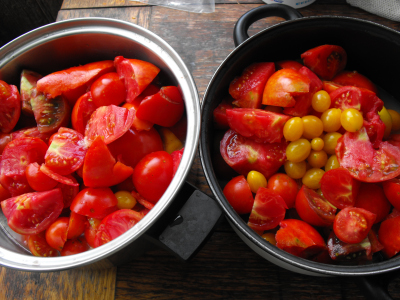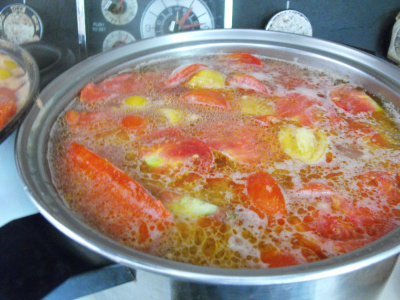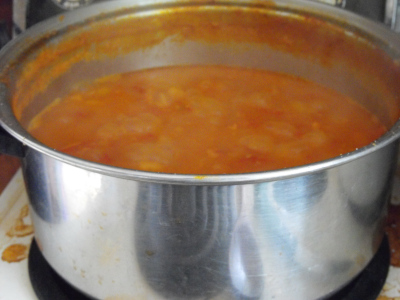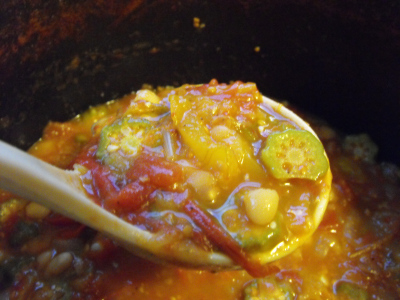
Harvest catch-all soup
 When
I was a junior in college, I spent my first summer away from home with
no cafeteria. In preparation, I
picked my father's brain for instructions on making my favorite
vegetable soup, pinning him
down on a specific number of onions, potatoes, tomatoes, and
more. But
it was a struggle to turn Daddy's words into a recipe, because that
wasn't the information he was trying to impart. Over a decade
later, I've finally figured out what my wise father was saying.
Yes,
I am a slow learner.
When
I was a junior in college, I spent my first summer away from home with
no cafeteria. In preparation, I
picked my father's brain for instructions on making my favorite
vegetable soup, pinning him
down on a specific number of onions, potatoes, tomatoes, and
more. But
it was a struggle to turn Daddy's words into a recipe, because that
wasn't the information he was trying to impart. Over a decade
later, I've finally figured out what my wise father was saying.
Yes,
I am a slow learner.
 Daddy
was teaching me the trick of cooking in season with the easiest
in-season recipe --- harvest catch-all soup. He was trying to get
through my thick noggin the notion that meals should begin in the
garden with what's fresh and numerous, rather than with a detailed
shopping list at the grocery store. Clearly, this soup had been
his mother's way of using up odds and ends --- bits of browned carrots,
wilted greens, anything that wasn't rotten but wasn't prime enough for
being served plain. And, in essence, the soup was simple --- make
a stock, then throw in whatever vegetables you have lying around.
Daddy
was teaching me the trick of cooking in season with the easiest
in-season recipe --- harvest catch-all soup. He was trying to get
through my thick noggin the notion that meals should begin in the
garden with what's fresh and numerous, rather than with a detailed
shopping list at the grocery store. Clearly, this soup had been
his mother's way of using up odds and ends --- bits of browned carrots,
wilted greens, anything that wasn't rotten but wasn't prime enough for
being served plain. And, in essence, the soup was simple --- make
a stock, then throw in whatever vegetables you have lying around.
 The
first step was to make a soup base. Daddy's method involves one
onion, some garlic, and a cup and a half of cabbage all sauteed in a
bit of oil,
then simmered for a couple of hours with two stalks of celery, an 18
ounce can of tomatoes, and enough water to fill up the pot. My
method (at the moment, and ever evolving) starts with three quarters of
a pot of halved tomatoes, enough chicken stock to submerge the fruits,
two onions, six big cloves of garlic (minced), a big
handful of parsley (chopped), and about half a cup of dry beans
(pre-soaked.) This is the part of the soup where you'll want to
follow a vague recipe, but you'll notice that parsley is a great
substitute for the much harder to grow celery, and that if you start
with stock you don't need to bother with the sauteeing step. This
is also where you can tweak the flavor to suit your particular tastes.
The
first step was to make a soup base. Daddy's method involves one
onion, some garlic, and a cup and a half of cabbage all sauteed in a
bit of oil,
then simmered for a couple of hours with two stalks of celery, an 18
ounce can of tomatoes, and enough water to fill up the pot. My
method (at the moment, and ever evolving) starts with three quarters of
a pot of halved tomatoes, enough chicken stock to submerge the fruits,
two onions, six big cloves of garlic (minced), a big
handful of parsley (chopped), and about half a cup of dry beans
(pre-soaked.) This is the part of the soup where you'll want to
follow a vague recipe, but you'll notice that parsley is a great
substitute for the much harder to grow celery, and that if you start
with stock you don't need to bother with the sauteeing step. This
is also where you can tweak the flavor to suit your particular tastes.
 After
simmering the soup base for two or more hours until it has halved in
volume, you can pretty
much throw in whatever you want --- preferably whatever's in season
that you're sick and tired of freezing. Vegetables will cook in a
bubbling pot of soup stock at about the same rate as they cook in a pot
of boiling water, so add the veggies a minute before you eat
(for sweet corn), ten minutes before you eat (for beans, okra, summer
squash, etc.), or forty-five minutes before you eat (for
potatoes.) You can make the soup into a stew like Daddy's, chock
full of so many vegetables that it should be eaten on a plate, or you
can keep your soup more Cambell's-like and just add in perhaps a quart
of vegetables in the final step.
After
simmering the soup base for two or more hours until it has halved in
volume, you can pretty
much throw in whatever you want --- preferably whatever's in season
that you're sick and tired of freezing. Vegetables will cook in a
bubbling pot of soup stock at about the same rate as they cook in a pot
of boiling water, so add the veggies a minute before you eat
(for sweet corn), ten minutes before you eat (for beans, okra, summer
squash, etc.), or forty-five minutes before you eat (for
potatoes.) You can make the soup into a stew like Daddy's, chock
full of so many vegetables that it should be eaten on a plate, or you
can keep your soup more Cambell's-like and just add in perhaps a quart
of vegetables in the final step.
Daddy concluded his
lesson with these words of wisdom: "Use a big pot. Your soup
will expand to fill the space provide." Nowadays, I make two pots
of soup at once during harvest time, the better to concentrate summer
goodness for winter delight.
Want more in-depth information? Browse through our books.
Or explore more posts by date or by subject.
About us: Anna Hess and Mark Hamilton spent over a decade living self-sufficiently in the mountains of Virginia before moving north to start over from scratch in the foothills of Ohio. They've experimented with permaculture, no-till gardening, trailersteading, home-based microbusinesses and much more, writing about their adventures in both blogs and books.
Want to be notified when new comments are posted on this page? Click on the RSS button after you add a comment to subscribe to the comment feed, or simply check the box beside "email replies to me" while writing your comment.

One of the things I love about making soup is that you can throw in pretty much anything edible and end up with something good - no need to measure anything, no need to worry if you don't have exactly the "right" ingredients, no following a recipe at all (or only using one as a guideline the first time you make it, heh). I just keep tasting - and smelling - through the process, and even if it's different every time, it's always delicious, so you can't complain!
That being said, I've never actually made a soup starting with a base of tomatoes (I tend to save the tomatoes for sauce and salsa). I'll definitely have to try this the next time I make soup!
And thank you, Errol, for the background information - "waste not, want not" is a good motto by which to live.
My favorite soup recipe is a creamy tomato basil soup. I love that it is easy to convert from grocery store ingredients to fresh from the garden ingredients, and it's just a very simple recipe in general:
In a large pot mix 4 cups stock (chicken, vegetable, or a mix), 1 28 oz can tomato puree (or about 3 cups pureed home grown tomatoes), and a big handful/1 bunch of julienned fresh basil (or about 2 ounces of that "fresh" basil puree from the chilled produce section, or a small handful of dried basil), a can of Rotel (or about 1/2 cup green chili peppers, or whatever peppers you have available for desired spice), and optional diced onion and/or celery.
Simmer until thickened (reduces maybe 1/3-1/2). If desired, add cooked, shredded chicken for last 10 minutes.
Take off heat, let cool about 5-10 minutes, add a big splash of heavy or whipping cream, salt to taste. Stir and serve.
This phenomenal with a grilled cheese sandwich on a cold day!